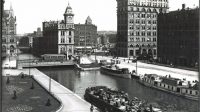Independent Learning: Secondary Color Correction for 360 Video
by Lucas Casino
- December 13
- in
Secondary Color Correcting 360-Degree Video In Premiere Pro CC
Between the films I make for class and the videos I produce for CitrusTV, I edit a LOT of footage. One sub-division of editing that I'm interested in and have begun to have some experience with is color correction. In the professional world, editors and color correctors are two sets of people that do completely different jobs. All of the video that you watch on a daily basis has been edited, but there is also very little that hasn't been color corrected.
Although I know how to utilize Premiere to give the footage a specific overall feel, I've only scratched the surface of color correction. Shifting the entire image, commonly known as Primary Color Correction, is not terribly difficult with most editing software, as the tools they include are pretty easy to grasp once you play around with them. With this YouTube video tutorial "Secondary Color Correcting 360 Video In Premiere Pro CC" by Studio 360 VR, I was able to begin to hone a few more skills that will enable me to make some more advanced color corrections, both in 2D and 360 video. Unfortunately, this video has not gained much traction since it was initially uploaded on October 30th, having only 204 views at the current time. That being said, I thought that Marcelo Lewin was a great teacher for this tutorial, and I hope that his video goes up in views as the market for editing 360 videos expands more and more.
The process of Secondary Color Correction involves changing the appearance of a specific area of the screen. For Marcelo's example he used the ceiling of a room. In the editing of my final project, I targeted the Rock Crusher at the quarry we explored. The actual set up of the edit is key. You have to make sure you are looking at a flat image of the 360 video in Premiere, while also viewing the content in a 360 player. This is to help you understand the physics of what you are editing as go along, being sure that you know what the edit is going to look like at every perspective. The biggest color correction tool that Premiere boasts is the "Lumetri Color" effect, which is a kind of all-in one color corrector. Using Lumetri Color, you can perform basic color correction by playing with all kinds of slider adjustments for temperature, tint, exposure, contrast, highlights, shadows, whites, blacks, saturation and so on. The "Free Draw Bezier" pen tool located at the top of the effect is what we're concerned with. By using this pen to connect points (like you would on photoshop) you can concentrate on one part of the image. Once you've really focused in and controlled the part of the image you want to change, you can use the rest of Lumetri Color's adjustments to change whatever you've outlined! Again, it's important to be looking at the footage in real time, so that you can see the final output. Using the "mask feather" and opacity settings, you can make the effect look less harsh on the edges and realistic.
I think I was able to give the Rock Crusher a pretty cool look in the end. Although it was annoying having to do it multiple times from different angles, I think that the end result was definitely worth the extra effort!


COMMENTS